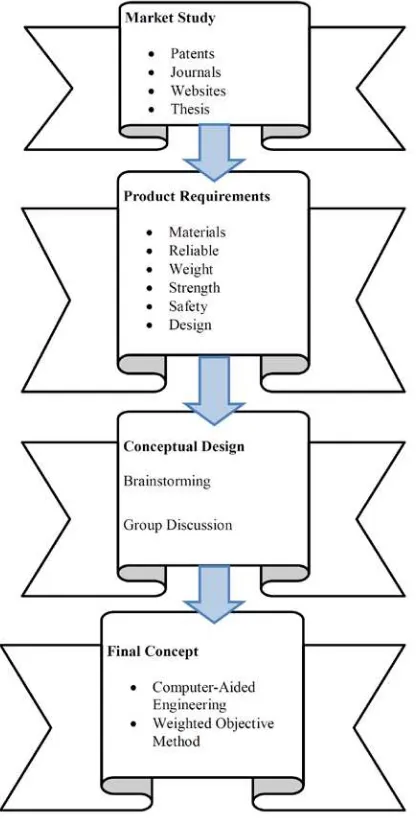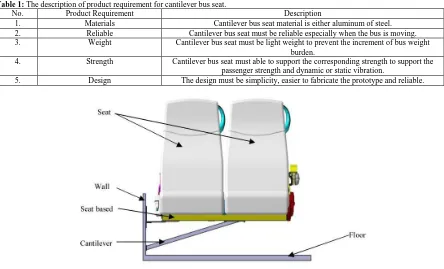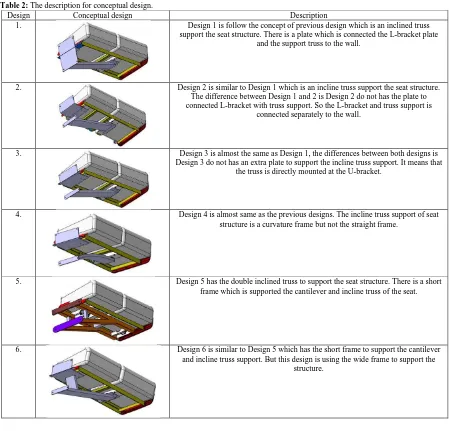Corresponding Author: Chee Fai Tan, Integrated Design Research Group (IDeA), Faculty of Mechanical Engineering, Universiti Teknikal Malaysia Melaka, Melaka, Malaysia
Conceptual Design of Cantilever Support for Long Haul Bus Passenger Seat
1
Chee Fai Tan, 1Z.Y. Tean, 2B.L. Tan, 2T.L. Lim, 1M.R. Said, 1M.N. Sudin, 1S.N. Khalil, 1J. Karjanto, 1
N.M. Yusof, 3W. Chen, 3G.W.M. Rauterberg, 4Sivarao
1
Integrated Design Research Group (IDeA), Centre of Advanced Research on Energy (CARE) Faculty of Mechanical Engineering, Universiti Teknikal Malaysia Melaka, Melaka, Malaysia
2
TKH Manufacturing Private Limited, Selangor, Malaysia 3
Designed Intelligence Group, Department of Industrial Design, Eindhoven University of Technology, Eindhoven, the Netherlands
4
Faculty of Manufacturing Engineering, Universiti Teknikal Malaysia Melaka, Melaka, Malaysia
Abstract: This paper describes the conceptual design of cantilever support for long haul bus passenger
seat. The advantages of cantilever bus seat structure is light weight, the luggage can be put under the seat and it is easy for floor cleanup. The total design technique was used to develop the cantilever support. Market survey was conducted to study on current available cantilever supported vehicle seat. After that, product requirement of cantilever design is defined. Next, brainstorming technique was used to generate the preliminary concept of cantilever design. Six conceptual designs were generated for selection. The matrix evaluation method was used to determine the final design of cantilever design. The weight of the concept was obtained through weighted analysis. Lastly, the final concept will be fabricated as prototype for further validation purpose.
Key words: Conceptual design, long haul, bus passenger, cantilever support.
INTRODUCTION
Nowadays, bus become an important public transportation for the consumer especially for the country which is shortage of motorized vehicles and excessive number of nonmotorized vehicles in the city cause the city street traffic jam (Andaleeb, 2007). Some country do not have the advanced technology like Germany, America or even Japan which are not faced the problem of transportation. So, public transport forms the major use of buses and coaches which is designed for the general public transportation or private hire (Ismail, 2010). Normally, the average time for a day of a bus to operate is 8 hours (Tan et al., 2007).
Nowadays, the transportation needs in the world is increasing cause the present of challenges for policy makers (Andaleeb, 2007). China, India, Mexico and Thailand can be the example due to the population of the country is increasing and those countries will demand for more and better transportation (Andaleeb, 2007). So, the improvement of public transportation becomes more significant (Ison and Wall, 2002). So, for developing countries which do not have modern technology improve the ground of transportation system in the city like some commuter train facilities, premium buses (air-conditioned), buses, minibuses, and taxis (Andaleeb, 2007).
Nowadays, the bus is divided into two types which are short haul bus (less than 2 hours of travel) and long haul bus (more than 2 hours of travel). Long haul bus also called as coach. The difference between the long haul and short haul bus is short haul bus is concern about the city traffic, the time stay for passengers on the bus and easy for passengers movement in the bus (Alvio, 1986). Meanwhile, the long haul bus is more focus on the comfortable of passengers because the passenger spend most of their in the bus (Alvio, 1986). For the long haul bus, the seat is placed apart from front-to-back with 70cm which is enough space for the passenger not to sit perfectly at all times and can rest or sleep (Chardon, 1981).
Design Methodology:
The total design process chart as shown in Figure 1 is divided into 4 steps. These steps are included market study, product requirement, conceptual design and final concept.
The first step is the market study. Information that related to cantilever supported vehicle seat was collected from internet or library. The information was referred to journals, thesis, patents, or any related websites to study the existing product in the market today. The information is important for design process.
The second step is the product requirement. Product requirement is the output of market study and it is the references and guideline to generate the idea. The product requirement is based on the importance of cantilever bus seat. So, materials, reliable, weight, strength, safety and design are selected as the product requirement for the design of cantilever bus seat structure. After that, the third step is conceptual design which was using brainstorming and group discussion as the tool to generate the conceptual design. The conceptual design was developed in three-dimensional views for simulation purposes. After that, the weighted objective method which is the fourth step to evaluate the product requirement based on the weighted to rate the conceptual design. So, there is one concept design is chosen as the best design for CAE simulation. The evaluation of conceptual design was using computer-aided engineering (CAE) to get the finite element analysis (Tan and Said, 2009; Said and Tan, 2009).
Fig. 1: The conceptual design process of cantilever bus seat structure.
Conceptual Design:
session was conducted by 5 people and each person was encouraged to generate their ideas. The ideas were recorded at stick notes and pasted on a paper. Next, the group discussion was conducted after the brainstorming session. Group discussion is discussed about the idea evaluation. After the group discussion, six design concepts were evaluated. As referred to Figure 2, it is shows the front view of the bus passenger seat with cantilever support. There is an incline truss support mounted on the wall with a L-shape bracket. There is a space under the bus passenger seat for their luggage.
Table 1: The description of product requirement for cantilever bus seat.
No. Product Requirement Description
1. Materials Cantilever bus seat material is either aluminum of steel.
2. Reliable Cantilever bus seat must be reliable especially when the bus is moving. 3. Weight Cantilever bus seat must be light weight to prevent the increment of bus weight
burden.
4. Strength Cantilever bus seat must able to support the corresponding strength to support the passenger strength and dynamic or static vibration.
5. Design The design must be simplicity, easier to fabricate the prototype and reliable.
Fig. 2: Front view of full double bus seat with cantilever support.
After the brainstorming and group discussion, 6 designs were generated as conceptual design. The following Table 2 is the description of concepts.
Concepts Evaluation:
The five design concepts were evaluated by using weighted objective method. The design concepts were evaluated based on the product requirements as shown in Table 1. At Table 3 below, there are 5 product requirements which been decided to evaluate the design concepts.
Each product requirement was set the corresponding weight score to indicate the importance of each requirement. The relative weight score of product are material (0.15), reliable (0.25), weight (0.10), strength (0.30) and design (0.20). The total weight is 1. Based on the table, strength rated the highest weight as compare to other requirement. It is because the cantilever bus seat requires strength to support the seat especially when the bus is moving. Other than that, the cantilever bus seat will mount on the wall, so the strength become very important.
Table 2: The description for conceptual design.
Design Conceptual design Description
1. Design 1 is follow the concept of previous design which is an inclined truss
support the seat structure. There is a plate which is connected the L-bracket plate and the support truss to the wall.
2. Design 2 is similar to Design 1 which is an incline truss support the seat structure. The difference between Design 1 and 2 is Design 2 do not has the plate to connected L-bracket with truss support. So the L-bracket and truss support is
connected separately to the wall.
3. Design 3 is almost the same as Design 1, the differences between both designs is Design 3 do not has an extra plate to support the incline truss support. It means that
the truss is directly mounted at the U-bracket.
4. Design 4 is almost same as the previous designs. The incline truss support of seat structure is a curvature frame but not the straight frame.
5. Design 5 has the double inclined truss to support the seat structure. There is a short frame which is supported the cantilever and incline truss of the seat.
6. Design 6 is similar to Design 5 which has the short frame to support the cantilever and incline truss support. But this design is using the wide frame to support the
structure.
Table 3: Weighted Objective Evaluation of Cantilever Bus Seat Concepts.
Concept 1 Concept 2 Concept 3 Concept 4 Concept 5 Concept 6
No Product
Requirement
Weight s v s v s v s v s v s v
1. Material 0.15 2 0.30 2 0.30 2 0.30 2 0.30 2 0.30 2 0.30
2. Reliable 0.25 2 0.50 3 0.75 4 1.00 3 0.75 4 1.00 3 0.75
3. Weight 0.10 4 0.40 4 0.40 5 0.50 4 0.40 2 0.20 3 0.30
4. Strength 0.30 3 0.90 5 1.50 5 1.50 4 1.20 5 1.50 4 1.20
5. Design 0.20 3 0.60 3 0.60 4 0.80 4 0.80 5 1.00 4 0.80
Total Value 1.00 2.70 3.55 4.10 3.45 4.00 3.35
Conclusion:
6 conceptual designs were developed with total design approach. The total design process is used as a guideline to develop the conceptual design. After the development of conceptual design, the weighted objective was used to identify the most suitable design for this project. Concept design 3 is chosen as the best design among the six designs. The materials used is steel, the reliable and strength is acceptable because it is referred the previous cantilever bus seat structure for short haul bus.
ACKNOWLEDGMENT
REFERENCES
Andaleeb, S.S., 2007. Reforming Innercity Bus Transportation in a Developing Country: A Passenger-Driven Model. Journal of Public Transportation, 10(1) : 1-4.
Chardon, M.M.F., 1981. Seat for Bus, Train or Airplane. US Patent 4,291,916. De Simon, A., 1986. Modular Bus Seat. European Patent 84201859.
Ismail, M.K., 2001. Ergonomics Design and Analysis of Bus Driver Seat. UTeM unpublished undergraduate thesis.
Ison, S. and S. Wall, 2002. Attitude to Traffic related issues in Urban aeas of the UK and the role of workplace parking changes.
Tan, C.F., F. Delbressine and G.W.M. Rauterberg, 2007. Vehicle seat design: state of the art and recent development. Proceedings of 3rd World Engineering Congress, pp: 51-61.
Tan, C.F., W. Chen and G.W.M. Rauterberg, 2009. Design of aircraft cabin testbed for stress free air travel experiment. 5th International Conference on Planning and Design, pp: 157.
Tan, C.F., W. Chen and G.W.M. Rauterberg, 2010. Total design of low cost aircraft cabin simulator. Proceedings of Design, pp: 1721-17280.
Tan, C.F. and S.S.S. Ranjit, 2013a. An interactive system for concurrent engineering design. Applied Mechanics and Materials, 313-314, pp: 990-994.
Tan, C.F., W. Chen and G.W.M. Rauterberg, 2013b. Total design of active neck support system for economy class aircraft seat. Applied Mechanics and Materials, 372: 657-660.
Tan, C.F., 2010. Smart system for aircraft passenger neck support. PhD Thesis, Eindhoven University of Technology.
Tan, C.F. and M.R. Said, 2009. Effect of hardness test on precipitation hardening aluminium alloy 6061-T6. Chiang Mai Journal of Science, 36(3): 276-286.


